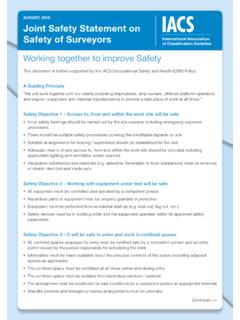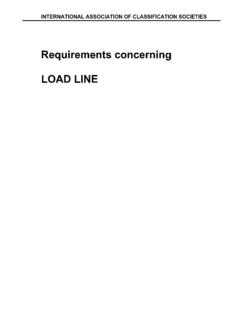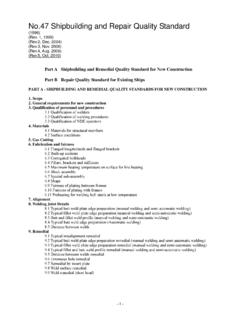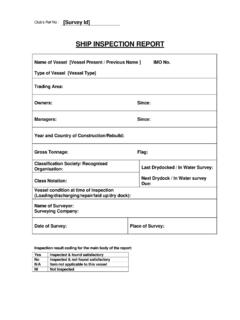Transcription of LNG BUNKERING GUIDELINES - IACS
1 Page 1 of 67 IACS Rec. 2016 No. 142 (cont) LNG BUNKERING GUIDELINES No. 142 (June 2016) Page 2 of 67 IACS Rec. 2016 No. 142 (cont) Table of Contents Chapter 1 General Section 1 Application Introduction Purpose LNG BUNKERING process and guideline structure Applicability LNG Bunker Management Plan (LNGBMP) Section 2 Definitions, applicable standards and rules Terms and definitions Standards and rules Section 3 BUNKERING methods Description of typical ship BUNKERING arrangements Examples of ship BUNKERING arrangements Section 4 Responsibilities during LNG BUNKERING Responsibilities during planning stage Responsibilities during BUNKERING operations Crew and Personnel Training and LNG awareness Section 5 Technical requirements for BUNKERING systems General Loading arms and hoses arrangements Couplings and connecting flanges Leakage detection ESD systems Emergency Release Coupling (ERC) Page 3 of 67 IACS Rec.
2 2016 No. 142 (cont) Communication systems BUNKERING transfer rate Vapour return line Lighting Page 4 of 67 IACS Rec. 2016 No. 142 (cont) Chapter 2 Risk Assessment Section 1 LNG BUNKERING operations risk assessment General Risk assessment approach Risk criteria Guidance on a typical Risk Assessment for LNG BUNKERING operations Section 2 Safety and security zones General Hazardous area classification Safety zones Security zones Page 5 of 67 IACS Rec. 2016 No. 142 (cont) Chapter 3 Functional and General Requirements for LNG BUNKERING Operation Section 1 Pre- BUNKERING phase Definition Goal Functional requirements General requirements Preparation for bunker transfer Pre- BUNKERING checklist Connection of the transfer system Section 2 BUNKERING phase Definition Goal Functional requirements General requirements Section 3 BUNKERING completion phase Definition Goal Functional requirements Draining, purging and inerting sequence Post- BUNKERING documentation Page 6 of 67 IACS Rec.
3 2016 No. 142 (cont) Annex: Guidance on HAZID and HAZOP for LNG BUNKERING operations Section 1 HAZID for LNG BUNKERING Objectives Scope Process Technique Guidewords Section 2 HAZOP for LNG BUNKERING operations Definition Process Scope Page 7 of 67 IACS Rec. 2016 No. 142 (cont) Chapter 1 - General Section 1 Application Section 2 Definitions, applicable standards and rules Section 3 BUNKERING methods Section 4 Responsibilities during LNG BUNKERING Section 5 Technical requirements for BUNKERING systems Page 8 of 67 IACS Rec. 2016 No. 142 (cont) Section 1 - Application Introduction LNG BUNKERING is developing worldwide in line with the increase of use of natural gas as a fuel compliant with environmental legislation. This guideline provides recommendations for the responsibilities, procedures and equipment required for LNG BUNKERING operations and sets harmonised minimum baseline recommendations for BUNKERING risk assessment, equipment and operations.
4 These GUIDELINES do not consider commercial aspects of the bunker transfer such as Bunker Delivery Notes and measurement of quantity or quality of LNG. Purpose The purpose of these GUIDELINES is mainly to define and cover the additional risks associated with BUNKERING LNG and to propose a methodology to deal with those additional risks in order to provide a similar level of safety as is achieved for traditional oil fuel BUNKERING operations. This document is designed to complement the requirements from the existing applicable GUIDELINES and regulations, such as port and terminal checklists, operator s procedures, industry GUIDELINES and local regulations. This guide provides guidance to clarify the gaps that have been identified in the existing guidance and regulations. In particular, the following items are covered: The responsibility of different parties involved in the LNG transfer, The LNG BUNKERING process, SIMOPS Safety distances, QRA and HAZID LNG BUNKERING process and guideline structure LNG BUNKERING is the process of transferring LNG fuel to a ship from a BUNKERING facility.
5 The sequence for a BUNKERING operation carried out between two parties for the first time is described in the following diagram; the references identify the applicable sections of the guideline. Page 9 of 67 IACS Rec. 2016 No. 142 (cont) Figure 1: BUNKERING process Risk Assessment Safety and Risk Assessment phase HAZID & HAZOP, QRA, Safety & Security zones Chapter 2 & AnnexLNG BUNKERING Management Plan Safety and Risk Assessment conclusions undertaken Administrative authorisation & Contractual agreement Chapter 3 Section 1 Compatibilty assessment Safety and Risk Assessment applied Selection of equipment, Training, check List Chapter 3 Section 1 Pre BUNKERING phase Preparation for safe BUNKERING Chapter 3 Section 1 Connection Inerting, coupling and testing Chapter 3 Section 1 BUNKERING phase Monitoring and management of the LNG transfer Chapter 3 Section 2 Disconnection Draining, purging, safe storage of the hose and couplings Chapter 3 Section 3 Post BUNKERING phase End of the BUNKERING operationPlanning Phase Operational Phase Page 10 of 67 IACS Rec.
6 2016 No. 142 (cont) Applicability These GUIDELINES are applicable to LNG BUNKERING operations for: Different methods, Different ship types, and Different locations (in port, off shore and terminal) worldwide. LNG Bunker Management Plan (LNGBMP) An LNG bunker management plan should be established in order for the involved parties to agree technically and commercially on methodology, flow rate, temperature, pressure of the delivery of LNG and receiving tank. This plan gathers together all the information, certificates, procedures, and checklist(s) necessary for an effective and safe LNG BUNKERING operation. The LNG Bunker Management Plan should be referenced as part of the safety management system of the RSO. Figure 2: Breakdown of LNGBMP content showing related sections of this guide LNG Bunker Management PlanChapter 1, Emergency Response PlanChapter 1, Instructions & TrainingChapter 1, & Security zones Chapter 2, Sec 2 Quantity and Quality AgreementBunker ProcedureChapter 3 Compatibilty AssessmentChapter 3, check ListEquipment Certificates Page 11 of 67 IACS Rec.
7 2016 No. 142 (cont) Section 2 - Definitions, applicable standards and rules Terms and definitions Atmospheric tanks Atmospheric tanks mean tanks of the types A or B or membrane tanks as defined in: IGC Code, regulations , and ; and IGF Code, regulations , and BUNKERING Facility Organisation (BFO) This is the organisation in charge of the operation of the BUNKERING facility. Breakaway Coupling (BRC) A breakaway coupling is a safety coupling located in the LNG transfer system (at one end of the transfer system, either the receiving ship end or the BUNKERING facility end, or in the middle of the transfer system), which separates at a predetermined section at a determined break-load or relative separation distance each separated section containing a self-closing shut-off valve, which seals automatically. BUNKERING facility A BUNKERING facility is normally composed of a LNG storage and a LNG transfer installation, a BUNKERING facility may be (a stationary shore-based installation or a mobile facility, a LNG bunker ship or barge or a tank truck).
8 A BUNKERING facility may be designed with a vapour return line and associated equipment to manage the returned vapour. Dry disconnect This applies when the transfer system between two vessels or a vessel and a port facility is disconnected as part of normal operations. The objective is that no LNG or natural gas should be released into the atmosphere. If this objective cannot be achieved, the amount released can be reduced to negligible amounts consistent with safety. Dry disconnect can be achieved by: Draining and inerting process before the disconnection; or Use of dry connect / disconnect coupling. Emergency Shut-Down (ESD) These are systems installed as part of the LNG transfer system that are designed to stop the flow of LNG and or prevent damage to the transfer system in an emergency. The ESD may consist of two parts, they are; Page 12 of 67 IACS Rec. 2016 No. 142 (cont) ESD - stage 1, is a system that shuts the LNG transfer process down in a controlled manner when it receives inputs from one or more of the following; transfer personnel, high or low level LNG tank pressure alarms, cables or other means designed to detect excessive movement between transfer vessels or vessel and an LNG BUNKERING facility, or other alarms.
9 ESD - stage 2, is a system that activates decoupling of the transfer system between the transfer vessels or between a vessel and an LNG BUNKERING facility. The decoupling mechanism contains quick acting valves designed to contain the contents of the LNG transfer line (dry break) during decoupling. Emergency Release Coupling (ERC) The ERC is normally linked to the ESD system where this may be referred to as ESD2 as per SIGTTO ESD arrangements & linked ship/shore systems for liquefied gas carriers . An emergency release coupling is activated: By excessive forces applied to the predetermined section, or By manual or automated control, in case of emergency. Emergency Release System (ERS) A system that provides a positive means of quick release of the transfer system and safe isolation of receiving vessel from the supply source. Flash Gas Boil-off Gas instantly generated during LNG transfer due to the warmer temperature of the receiving ship tanks, sudden pressure drop or friction.
10 HAZOP A structured and systematic examination of a planned or existing process or operation in order to identify and evaluate problems that may represent risks to personnel or equipment, or prevent efficient operation. A HAZOP is a qualitative technique based on guide-words and is carried out by a multi-disciplinary team of experts during a set of meetings. HAZID Hazard identification exercise, there are a number of recognised methods for the formal identification of hazards. For example: a brainstorming exercise using checklists where the potential hazards in an operation are identified and gathered in a risk register these will then be assessed and managed as required. Hazardous zones BUNKERING -related hazardous zone means any hazardous area zone 1 or zone 2 defined for: The receiving ship in accordance with IGF Code1, regulation ; 1 The IGF Code adopted by Resolution (95) Page 13 of 67 IACS Rec.









